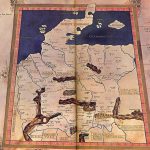Chapters
On the European continent, the Roman Empire based its border on two great rivers: the Rhine and the Danube. There was, however, a fundamental problem with this concept – both rivers in their initial course diverge, creating an obtuse angle on the map. This meant that the area between them cut quite deep into the Roman territory to the southwest. So it was a sensitive place where barbarians could easily enter the Empire. To prevent this, the Romans took over the lands between the upper reaches of the Rhine and Danube rivers. These areas in ancient times were called Agri Decumates, which means “tithe lands” in Polish. Today, the area is mostly located in the state of Baden-Württemberg in Germany.
Name and population
The origin of the name Agri Decumates is not entirely clear. Most of the theories so far derived the origin of the name from the tithe tax, which meant that the inhabitants of these areas paid the Roman emperor a tax of a tenth of their income. This view is often criticized by etymologists who hypothesize that the name also comes from the unknown town of Decuma or Decumum.
Roman historian Tacitus in his description of the population of Agri Decumates from 98 CE does not include the population living there as Germans – there lived a Gallic population, which necessity forced to settle across the Rhine. The areas a little further to the north were inhabited by the German Sueves – especially in the vicinity of the mouth of today’s Neckar River (in antiquity the Latin name Neccarus or Nicarus). This theory is confirmed by the name of one of the cities near the mouth of the Neckar – Ulpia Sueborum Nicretum.
Roman control
The subordination of the Agri Decumates to the Roman Empire began with Emperor Vespasian in 72 CE, although these areas were probably indirectly subject to Rome before that. By 80 CE conquered a large strip of land located centrally between the Rhine and the Danube. Vespasian founded the city of Arae Flaviae (now Rottweil) here, located near the sources of the Neckar. A strip of land across the Rhine, extending from Argentoratum (now Strasbourg in France) to beyond Mogontiacum (now Mainz), was also subordinated. During the reign of Vespasian’s younger son, Domitian, territorial gains were consolidated, and around 85 CE the construction of a belt of timber and earth fortifications on the borders with the Germans, later called the Upper Germanic-Rhaetian limes, was started. At that time, the areas of Agri Decumates were also incorporated into the Roman province of Upper Germania (Germania Superior in Latin).
During the reign of Trajan the frontier of the Empire was pushed further north-east, virtually eradicating the barbaric wedge in Roman territory. In the north, the areas beyond the Rhine were captured, opposite the Roman fortress of Confluentes (today’s Koblenz) at the mouth of the Moselle to the Rhine. In the central part of Agri Decumates limes were based on the Necarus River. The remains of the Roman municipium on the Neckar are located in the Stuttgart district – Bad Cannstatt (the Roman name of this town is unknown). In the south, a large area north of the Danube was taken over. The largest Roman settlement in this area was Castellum Aquilea (now Heidenheim an der Brenz). This southern part of the Agri Decumates was included in the province of Raetia – hence, from the names of both provinces, the fortifications on the border were called the Upper Germanic-Raetian limes.
Before 160 CE during the reign of Antoninus Pius, the Romans managed to further strengthen the territory of the Agri Decumates. In the central part, the border was moved further north-east, moving the border away from the Necarus River. It was the farthest range of Roman conquests in this area and the remains of this border are the proper Upper Germanic-Rhaetian limes. It is described as the longest Roman belt of fortifications without a natural border (after moving the border away from the Neckar, only a short fragment of the limes ran along the river Main).
Agri Decumates under Roman rule
Under Roman rule, the area of tithe lands flourished. The continuous stay of numerous Roman troops made the inhabitants profit from trade and agriculture. A lot of Romanized people settled here, mostly from Gaul. The latest research by German archaeologists states that around 250,000 people lived in the entire Agri Decumates area, which, together with the Roman legions stationed there, made the area one of the most densely populated in the entire Empire. There were about 60 rural settlements (vici) and 1,300 agricultural farms (so-called villae rusticae). This number indicates that the area was heavily exploited for agriculture. The only city in Agri Decumates whose inhabitants before Caracalla’s edict from 212 CE held Roman citizenship was founded by Vespasian Arae Flaviae.
Loss of area by the Romans
At the end of the 2nd century CE barbarian pressure on the fortifications of the limes increased, tribes from the interior of Germania were probably approaching the Roman borders. In 185 CE Commodus had to renovate and extend a large part of the fortifications. In 213 CE Emperor Caracalla led a retaliatory expedition against the Germans after the destruction of fragments of limes. However, the real beginning of the problems of the Romans in the Agri Decumates was the movement of a large part of the Rhine army, primarily the cavalry, to the east of the empire in 232 CE. It was caused by the successes of the recently established (around 225 CE) Persian Empire in the fight against Rome. Alexander Severus’ campaign against the Persians repulsed the danger but emboldened the Germans to cross the limes. In 233 CE The Alamanni plundered and destroyed a large part of the Roman fortifications, broke into the Agri Decumates, along the Rhine and into the Alpine foothills beyond the Danube. Auxiliary infantry units left on the border could not cope with the barbarian heavy cavalry without the help of cavalry. In 235 CE Alexander Severus, after returning from the east, undertook an expedition against the Alamanni, but he was more concerned with trying to bribe the barbarians than with the war. This was the direct cause of the rebellion and murder of the last emperor of the Severan dynasty. Perhaps one of the reasons was also the nervous army of the Rhine, which left its traditionally defensive lands, leaving their families and fortunes to the barbarians. The new Emperor Maximinus Thracian undertook a retaliatory expedition deep into barbarian territory, possibly reaching as far as the Harz Mountains. After the invasion of 233 CE, the reconstruction of the limes began, replacing the palisade with lines of embankments and ditches, making it difficult for barbarian cavalry attacks. Archaeological excavations show that many civilian settlements were only partially or provisionally rebuilt, numerous military facilities were reduced in size, and garrisons were permanently reduced. The main reason for this incomplete reconstruction was the lack of money – the Empire was in crisis: money was spent on wars in the east, extra pay for soldiers, and numerous usurpations reduced tax revenues.
The final abandonment of the Agri Decumates and Upper Germanic-Rhaetian limes by the Roman army took place during the reign of Emperor Valerian, in the years 253 – 260 CE, when he was busy with wars with Persia. It was not a surprise if the frontier defences were temporarily rebuilt and large numbers of troops once again marched to the east of the Empire. In 260 CE The Alamanni carried out a large invasion of Gaul, reaching almost the Atlantic, and the Jutungi, crossing the Rhaetian fragment of the limes, threatened northern Italy. After these invasions, the Roman army did not return to the line of fortifications and based its defence again on the Rhine and Danube.
Exit
Despite the abandonment of Agri Decumates by the Roman army, part of the Romanized population remained in this area and mixed with the immigrant Germanic population. From about 300 CE Roman sources no longer define the area between the upper Rhine and the Danube with a Latin name, but with a barbaric one – Alamania. Despite this, the emperors reigning in the fourth century CE undertook military expeditions to the areas of the former “tithe lands”. They were probably temporarily overrun around 360 CE. by Emperor Julian the Apostate. The last Roman expedition to this area was undertaken by Emperor Gratian in 377 CE
Today, the remains of the fortifications of the Upper Germanic Rhaetian limes are one of the biggest tourist attractions in southwestern Germany. In 2005, they were inscribed on the UNESCO World Heritage List.







